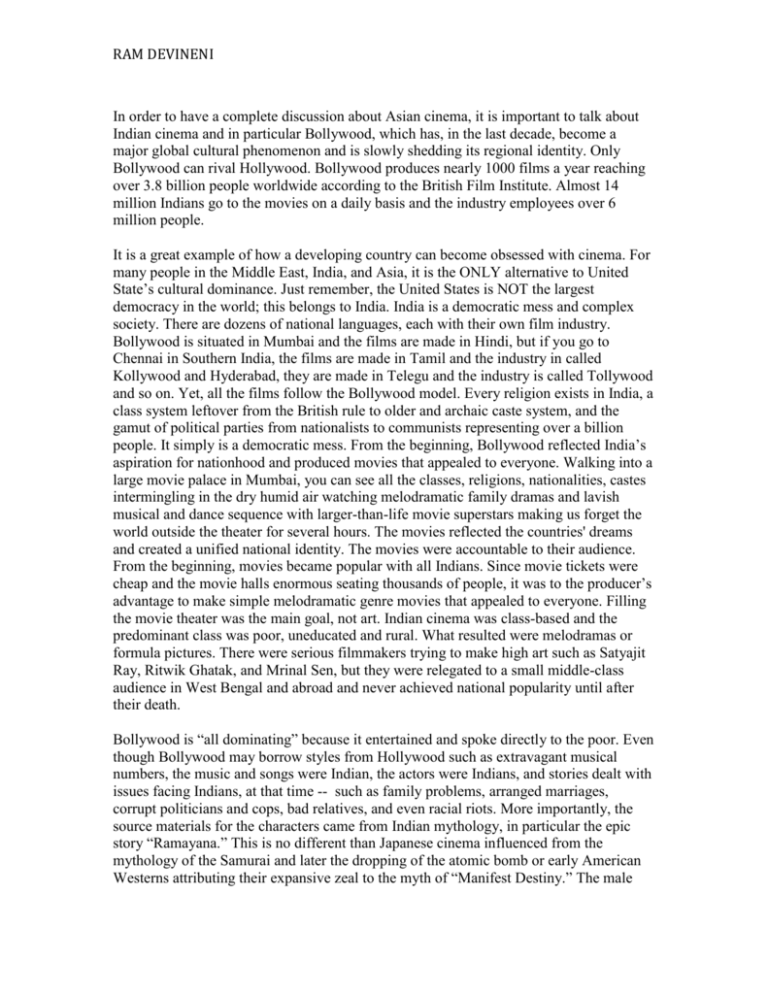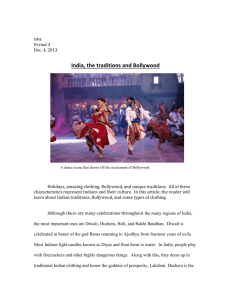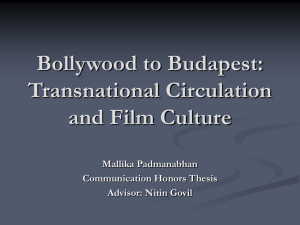RAM DEVINENI In order to have a complete discussion about Asian
advertisement

RAM DEVINENI In order to have a complete discussion about Asian cinema, it is important to talk about Indian cinema and in particular Bollywood, which has, in the last decade, become a major global cultural phenomenon and is slowly shedding its regional identity. Only Bollywood can rival Hollywood. Bollywood produces nearly 1000 films a year reaching over 3.8 billion people worldwide according to the British Film Institute. Almost 14 million Indians go to the movies on a daily basis and the industry employees over 6 million people. It is a great example of how a developing country can become obsessed with cinema. For many people in the Middle East, India, and Asia, it is the ONLY alternative to United State’s cultural dominance. Just remember, the United States is NOT the largest democracy in the world; this belongs to India. India is a democratic mess and complex society. There are dozens of national languages, each with their own film industry. Bollywood is situated in Mumbai and the films are made in Hindi, but if you go to Chennai in Southern India, the films are made in Tamil and the industry in called Kollywood and Hyderabad, they are made in Telegu and the industry is called Tollywood and so on. Yet, all the films follow the Bollywood model. Every religion exists in India, a class system leftover from the British rule to older and archaic caste system, and the gamut of political parties from nationalists to communists representing over a billion people. It simply is a democratic mess. From the beginning, Bollywood reflected India’s aspiration for nationhood and produced movies that appealed to everyone. Walking into a large movie palace in Mumbai, you can see all the classes, religions, nationalities, castes intermingling in the dry humid air watching melodramatic family dramas and lavish musical and dance sequence with larger-than-life movie superstars making us forget the world outside the theater for several hours. The movies reflected the countries' dreams and created a unified national identity. The movies were accountable to their audience. From the beginning, movies became popular with all Indians. Since movie tickets were cheap and the movie halls enormous seating thousands of people, it was to the producer’s advantage to make simple melodramatic genre movies that appealed to everyone. Filling the movie theater was the main goal, not art. Indian cinema was class-based and the predominant class was poor, uneducated and rural. What resulted were melodramas or formula pictures. There were serious filmmakers trying to make high art such as Satyajit Ray, Ritwik Ghatak, and Mrinal Sen, but they were relegated to a small middle-class audience in West Bengal and abroad and never achieved national popularity until after their death. Bollywood is “all dominating” because it entertained and spoke directly to the poor. Even though Bollywood may borrow styles from Hollywood such as extravagant musical numbers, the music and songs were Indian, the actors were Indians, and stories dealt with issues facing Indians, at that time -- such as family problems, arranged marriages, corrupt politicians and cops, bad relatives, and even racial riots. More importantly, the source materials for the characters came from Indian mythology, in particular the epic story “Ramayana.” This is no different than Japanese cinema influenced from the mythology of the Samurai and later the dropping of the atomic bomb or early American Westerns attributing their expansive zeal to the myth of “Manifest Destiny.” The male RAM DEVINENI heroes in Bollywood movies took on the persona of Lord Rama – heroic, trustworthy, and fighting for what is good and fair, while the women in the movies were like Rama’s wife, Seeta, who was loyal, dutiful and beautiful. Even though the heroes have changed and become rougher, overall these principles exist today in Bollywood movies. Since the actors took on the persona of gods, they were often treated like GODS by their fans. In a polytheistic country like India, we can choose which Gods to worship and the people clearly worshipped in the Temple of Bollywood. Although India won its Independence in 1947, it was economically stagnate under a quasi socialist and highly bureaucratic government controlled model. In the 1990s, on the brink of bankruptcy, the Indian government began to dismantle the socialist system and adopt a free-market approach. As a result, millions of people elevated themselves out of dire poverty into the middle class. For the first time, a large section of the Indian population had expendable money and they wanted to spend it. As a result, a significant cultural divide has occurred between the growing prosperous middle class in large urban areas and the poor rural class living in small towns throughout India. Reflecting these dramatic changes in India, Bollywood is going through unparallel changes locally and internationally. In the last century, Indians were having a debate about themselves. What does it mean to be Indian? What is the Indian nation? Bollywood produced movies that helped define a nation. A classic example is the 1957 film “Mother India”, which was made a decade after independence and was nominated for a Best Foreign Language Oscar. The film is about a widowed mother living in a small village-farm with her two sons. When her sons’ grow-up, one is dutiful and good while the other becomes a bandit and terrorizes the village where they live. By the end of the film, she makes an agonizing decision to kill her bad son in order to save the residents of the village from his treacherous acts. In the new century, as India enters the international stage as an economic, cultural and nuclear power, the discussion has shifted to what is the role of India in the world? The new Indian is not a rural farmer, but a technology savvy urbanite that frequently vacations in Singapore and has relatives in the UK. The mega studio, Yash Raj Films caters to the globetrotting Indian by producing movies where affluent Indians frequently go to work in helicopters and live on large estates right out of a Jane Austen novel. Movies like “Jhoom Barbara Jhoom” aka “Dance Baby Dance” have characters that are self-absorbed, rich, consumeristic and their life-long goal is finding Mr. Right driving a Maserati. This vision of India contrasts dramatically with the rural poor self-sacrificing mother in “Mother India.” Of course, most Indians are not at all like the characters in a Yash Raj movie, but the films reflect India’s aspirations in the new century. Critical to this debate is the millions of NRI’s or non-residing Indians who have migrated to the UK, USA, Canada, Australia, South Africa and other parts of Asia and Africa. The NRI’s combined wealth equals to the entire wealth of a billion Indians living in India. So, the Indians living abroad have a major influence on India and in particular on Bollywood. They have been critical in spreading the gospel of Bollywood and introducing it to nonIndians in Western countries. At times, a Bollywood movie could be a major flop in RAM DEVINENI India, but make an enormous profit from NRIs in the UK. The box office receipts of a dozen theaters in London could equal all of the ticket sales in India. As the “new” Indian begins to emerge into the world scene, Bollywood is following him or her. Many film scholars consider this period of time in Indian cinema as a monumental transitional period. Several important trends are happening which I will describe: First, the Indian government recognized the Indian film industry as an official industry only in 2000. Previously it was considered as a hobby, even though it was the 6th largest industry in India. In the chaotic days of movie making, producers raised money to make their film by finding investors like local shopkeepers, fabric manufacturers, the local gangster and sometimes winnings from the horse races. Yet, they were making 1000 films a year. Once the government recognized the movie industry; banks and businesses could legitimately invest in the film business. This started the movement to the corporatizing of Bollywood and the creation of large studios following the Hollywood model. The leading ones are Yas Raj Films and AdLabs Films. Second, the multiplex movie theaters are replacing the large cinema halls, especially in cities. Strangely, this is opening the industry towards smaller and more personal movies because a producer does not need to make a large generic film to fill a 2000-seat movie hall. Now a producer can make an artistic movie for educated middle-class viewers because in a multiplex, he only needs to fill a 200-seat theater. Additionally, ticket prices are 10x more expensive in a multiplex, so high price barriers automatically exclude the poor. Third, the propagation of cable television is growing. Over 100 million Indians own TVs and of that number, 77 million subscribe to cable – mostly in the cities where it is easier to run cable wires and provide service. With hundreds of channels to watch, this medium is affecting audience turnouts at movie theaters. But Bollywood studios are expanding their reach in to TV by developing and producing shows for this market. Even though these changes are causing a cultural divide between the classes, what still remains to be true with all Indians is that they want to see Indians on the big screen. The saturation of Hollywood and foreign films remains very low – less than 10%. As a result, major Hollywood studios like Walt Disney, Sony and others are producing Bollywood movies with Bollywood actors in order to penetrate the Indian market. I do not think Bollywood movies will replace Hollywood movies as the dominant form of entertainment, but it will continue to be an expanding influence on world culture. I will end with a striking fact. In China, over half the population is over 50 years old, while in India over half the population is under 25 years old. What this means is that in the near future, there will be more Indians on this planet than anyone else and they will all be drinking their dose of Bollywood chai.








